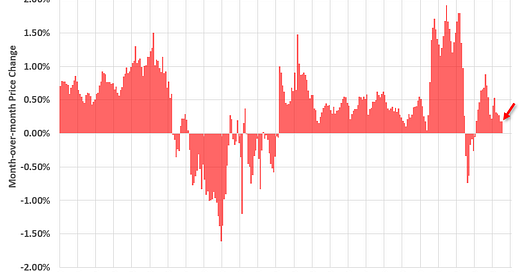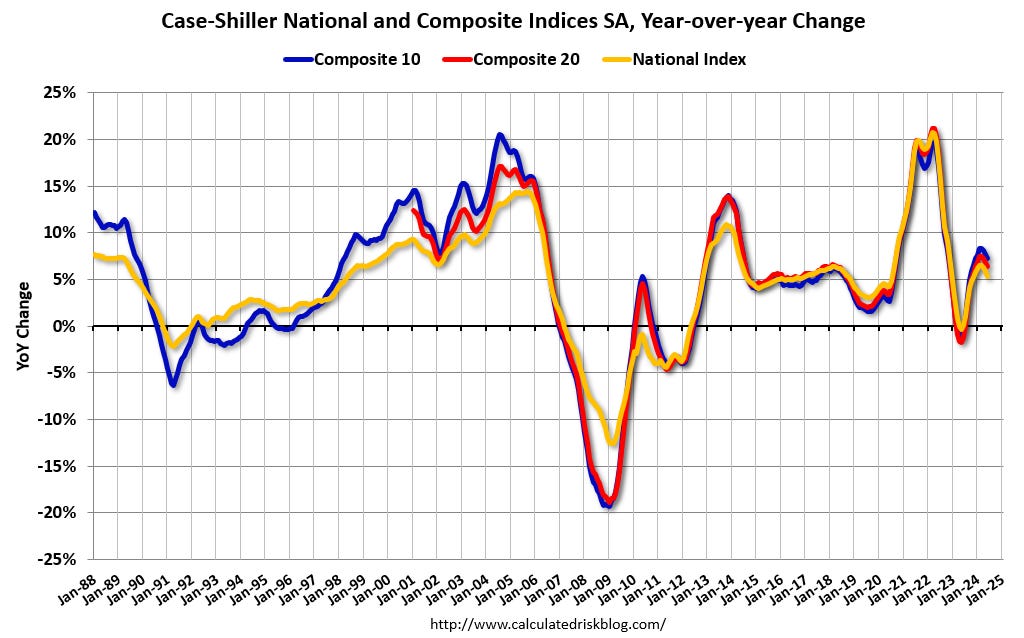Case-Shiller: National House Price Index Up 5.0% year-over-year in July
Over last 3 months, FHFA Index has increased at a 0.7% Annual Rate
S&P/Case-Shiller released the monthly Home Price Indices for July ("July" is a 3-month average of May, June and July closing prices). July closing prices include some contracts signed in March, so there is a significant lag to this data. Here is a graph of the month-over-month (MoM) change in the Case-Shiller National Index Seasonally Adjusted (SA).
For the second consecutive month, the MoM increase in the seasonally adjusted (SA) Case-Shiller National Index was at 0.18% (a 2.2% annual rate), This was the eighteenth consecutive MoM increase, but this tied the previous as the smallest MoM increase in the last 18 months.
On a seasonally adjusted basis, prices increased month-to-month in 18 of the 20 Case-Shiller cities. Seasonally adjusted, San Francisco has fallen 7.1% from the recent peak, Phoenix is down 4.2% from the peak, Portland down 3.1%, and Seattle and Denver are both down 2.9%.
FHFA House Price Index
On the FHFA index: FHFA House Price Index Up 0.1 Percent in July; Up 4.5 Percent from Last Year
U.S. house prices rose 0.1 percent in July, according to the Federal Housing Finance Agency (FHFA) seasonally adjusted monthly House Price Index (HPI®). House prices rose 4.5 percent from July 2023 to July 2024. The previously reported 0.1 percent price decrease in June was revised upward to 0.0 percent.
For the nine census divisions, seasonally adjusted monthly price changes from June 2024 to July 2024 ranged from -0.7 percent in the South Atlantic division to +0.9 percent in the East North Central and New England divisions. The 12-month changes were all positive, ranging from +1.6 percent in the West South Central division to +7.5 percent in the East North Central division.
“For the third consecutive month U.S. house prices showed little movement,” said Dr. Anju Vajja, Deputy Director for FHFA’s Division of Research and Statistics. “Gradually declining mortgage rates and relatively flat house prices may improve housing affordability.”
emphasis added
The seasonally adjusted monthly index was increased 0.1% in July. Here is a graph from the FHFA report showing the annual change by region for July 2024 compared to July 2023. Prices have increased year-over-year everywhere. Note that the YoY increase is larger this year, compared to the YoY increase in July 2023 in four of the nine regions.
Over the last 3 months, the FHFA seasonally adjusted index has increased at 0.7% annual rate (almost unchanged).
Case-Shiller House Prices
From S&P S&P CoreLogic Case-Shiller Index All-Time Highs Continue in July 2024
The S&P CoreLogic Case-Shiller U.S. National Home Price NSA Index, covering all nine U.S. census divisions, reported a 5.0% annual gain for July, down from a 5.5% annual gain in the previous month. The 10-City Composite saw an annual increase of 6.8%, down from a 7.4% annual increase in the previous month. The 20-City Composite posted a year-over-year increase of 5.9%, dropping from a 6.5% increase in the previous month. New York again reported the highest annual gain among the 20 cities with an 8.8% increase in July, followed by Las Vegas and Los Angeles with annual increases of 8.2% and 7.2%, respectively. Portland held the lowest rank for the smallest year-over-year growth, notching the same 0.8% annual increase in July as last month.
...
The U.S. National Index, the 20-City Composite, and the 10-City Composite upward trends continued to decelerate from last month, with pre-seasonality adjustment increases of 0.1% for the national index, and both the 20-City and 10-City Composites remained unchanged on the month.
After seasonal adjustment, the U.S. National Index posted a month-over-month increase of 0.2%, while both the 20-City and 10-City Composite reported a monthly rise of 0.3%.
“Accounting for seasonality of home purchases, we have witnessed 14 consecutive record highs in our National Index,” says Brian D. Luke, CFA, Head of Commodities, Real & Digital Assets. “While the S&P 500 has achieved 39 record highs and the S&P GSCI Gold TR hit 35 record highs, housing is following a similar trajectory. The growth has come at a cost, with all but two markets decelerating last month, eight markets seeing monthly declines, and the slowest annual growth nationally in 2024. Overall, the indices continue to grow at a rate that exceeds long-run averages after accounting for inflation.
“We continue to observe outperformance in most low-price tiers in the market on a three- and five-year horizon,” Luke continued. “The low-price tier of Tampa was the best performing market nationally with five-year performance of 88%. The New York market was the best market annually, posting a gain of 8.9%. New York’s low-tier index, which include home values up to $533,000, helped drive that growth with 10.8% annual gains. Over five years, markets such as New York and Atlanta saw low-price-tiered indices outperforming their market by as much as 20% and 18%, respectively. The relative outperformance of low-price-tiered indices has both benefited first-time homebuyers as well as made it more difficult for those looking for a starter home. The opposite is happening in California, which has the most expensive high-price tiers in the nation, all well over $1 million. The rich are getting richer in San Diego, Los Angeles, and San Francisco where their high-price-tiered indices outperformed on a one- and three-year basis.”
emphasis added
This graph shows the nominal seasonally adjusted Composite 10, Composite 20 and National indices (the Composite 20 was started in January 2000).
The Composite 10 index was up 0.3% in July (SA). The Composite 20 index was up 0.3% (SA) in July. The National index was up 0.2% (SA) in July.
The Composite 10 SA was up 6.8% year-over-year (down from 7.4% the previous month). The Composite 20 SA was up 5.9% year-over-year (down from 6.5%). The National index SA was up 5.0% year-over-year (down from 5.5%).
And a few things to watch …
The following content is for paid subscribers only. Thanks to all paid subscribers!
Keep reading with a 7-day free trial
Subscribe to CalculatedRisk Newsletter to keep reading this post and get 7 days of free access to the full post archives.







